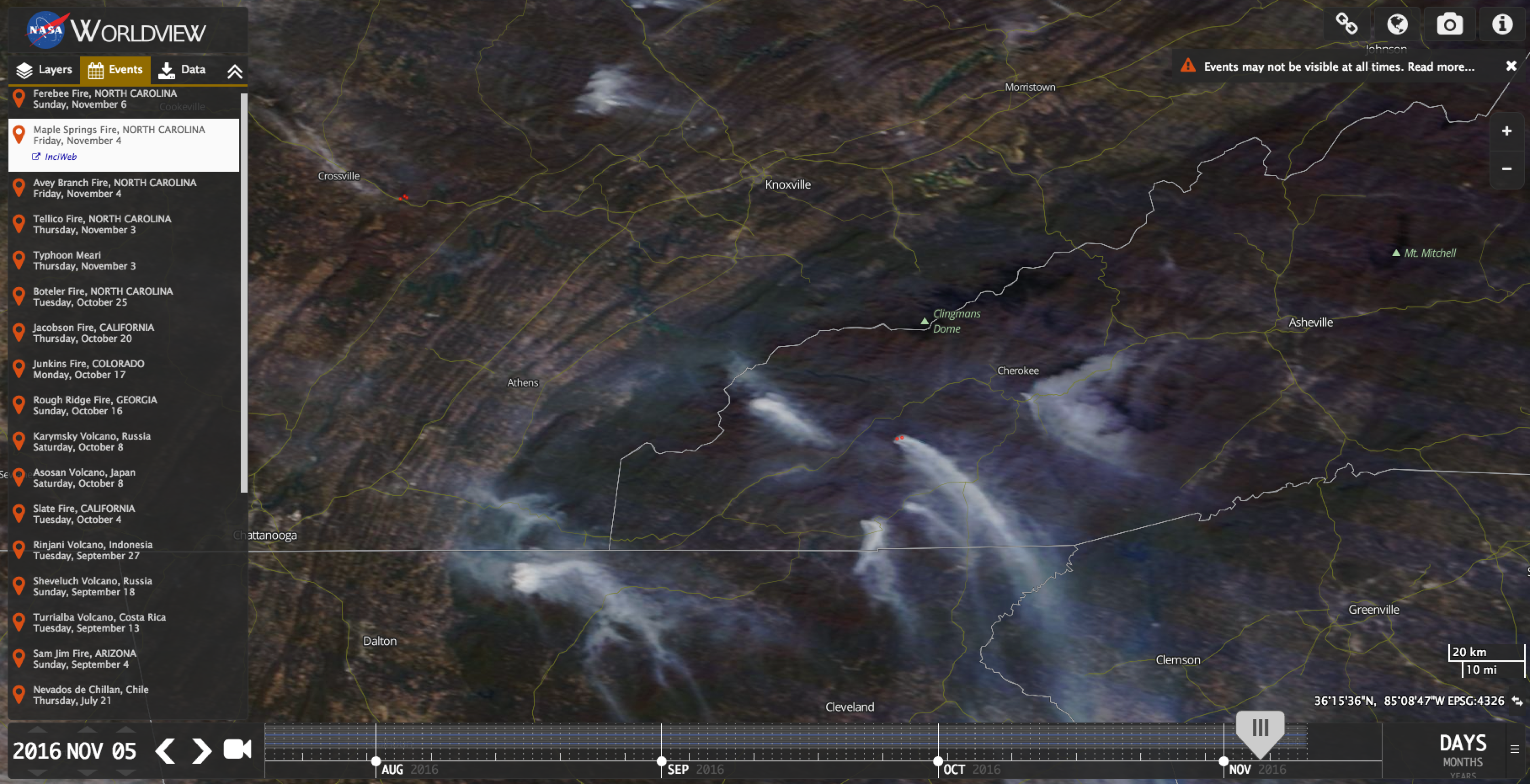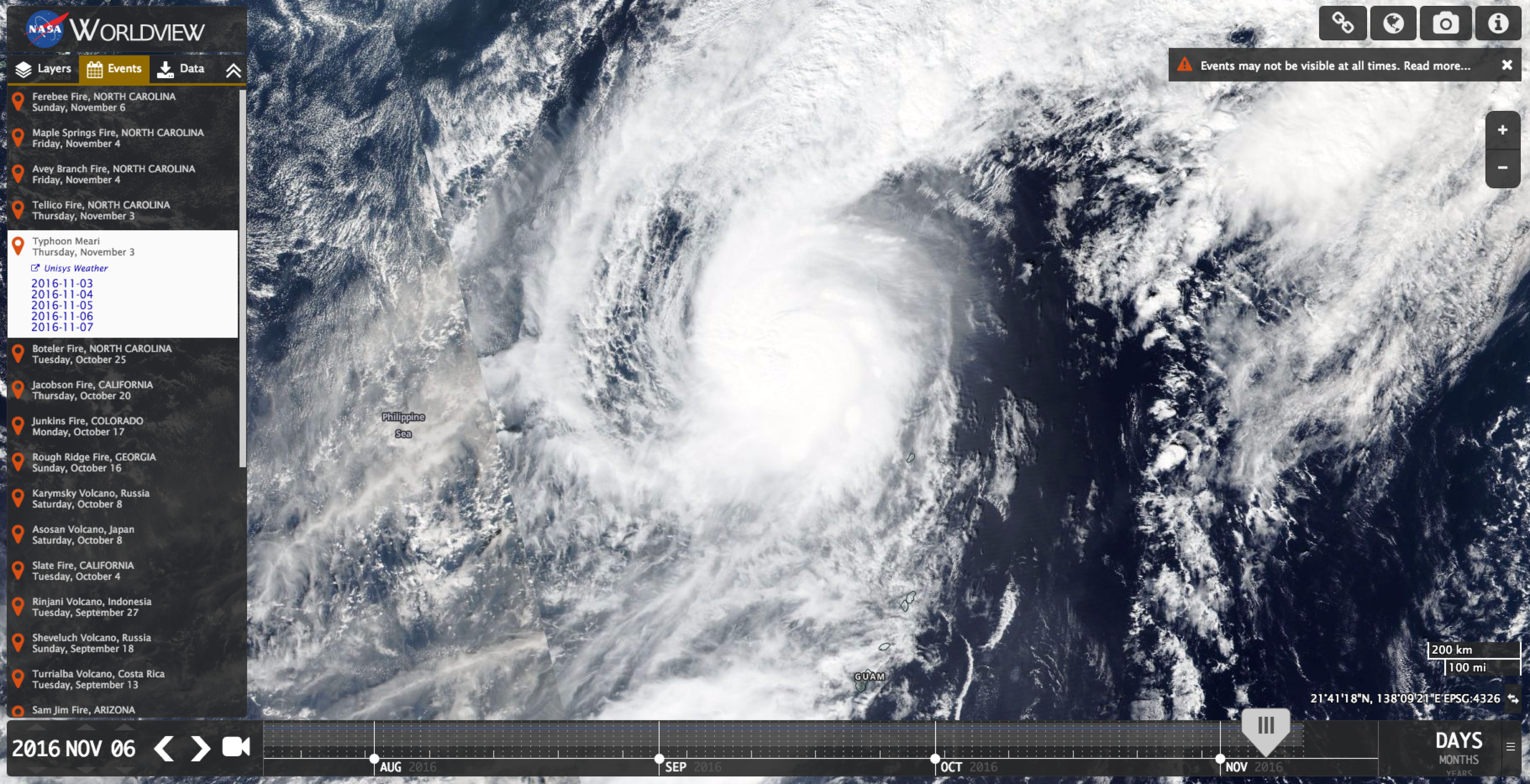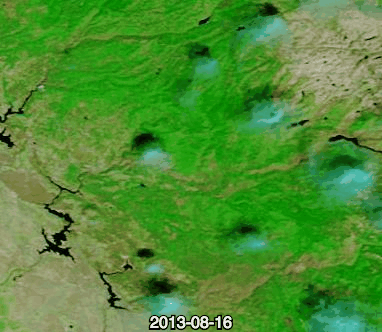We have been very, very behind with our GIBS blog - we will make a concerted effort this year to ensure that this blog is kept up-to-date and you are wowed by all of our great new additions to GIBS! We also plan to announce any Worldview related updates here as well. Worldview is our web mapping client, powered by GIBS imagery.
We have A LOT of new imagery up in GIBS (and Worldview) since our last blog post, check it out below!
New imagery available in GIBS and Worldview
MODIS/Aqua and Terra Collection 6 Atmosphere (24 February 2000 - present (Terra); 3 July 2002 - present (Aqua)) DMSP-F8 SSMI, DMSP-F10 SSMI, DMSP-F11 SSMI, DMSP-F13 SSMI, DMSP-F14 SSMI, DMSP-F15 SSMI, DMSP-F16 SSMIS, DMSP-F17 SSMIS (9 July 1987 - present: almost 30 years of data! ) MODIS/Terra Vegetation Indices (15 September 2016 - present)Normalized Difference Vegetation Index (NDVI) Enhanced Vegetation Index (EVI) SAC-D/Aquarius Soil Moisture (Daily) (25 August 2011 - 7 June 2015)DMSP 5D-3 F17/SSMIS, DMSP 5D-3 F18/SSMIS (26 October 1978 - present) SMAP (31 March 2015 - 25 December 2016) AMSR2 (13 January 2016 - present)
New imagery available in GIBS (soon to be available in Worldview)
Terra/MISRDHR Average (Monthly, Natural Color) (February 2000 - February 2016) Radiance Average (Monthly, Natural Color) (February 2000 - February 2016) Radiance Average (Monthly, Infrared Color) (February 2000 - February 2016) Aerosol Optical Depth Average (Green, Monthly) (February 2000 - August 2016) Land NDVI Average (Monthly) (February 2000 - August 2016) TOA Albedo Average (Red, Monthly) (February 2000 - August 2016) Cloud Stereo Height (No Wind Correction, < 0.5 km, Monthly) (February 2000 - August 2016) Cloud Stereo Height (No Wind Correction, < 1.5 – 2.0 km, Monthly) (February 2000 - August 2016) Terra/MOPITTCarbon Monoxide (Daily, Day, Surface Mixing Ratio) (1 March 2000 - 24 May 2016) Carbon Monoxide (Monthly, Day, Surface Mixing Ratio) (March 2000 - March 2016) Carbon Monoxide (Daily, Night, Surface Mixing Ratio) (1 March 2000 - 24 May 2016) Carbon Monoxide (Monthly, Night, Surface Mixing Ratio) (March 2000 - March 2016) Carbon Monoxide (Daily, Day, Total Column) (1 March 2000 - 24 May 2016) Carbon Monoxide (Monthly, Day Total Column) (March 2000 - Marc 2016) Carbon Monoxide (Daily, Night, Total Column) (1 March 2000 - 24 May 2016) Carbon Monoxide (Monthly, Night, Total Column) (March 2000 - March 2016) Terra/CERESSurface CRE Net Longwave Flux (Monthly) (March 2000 - November 2015) Surface Longwave Flux (Monthly, Energy Balanced and Filled, Down, All-Sky) (March 2000 - November 2015) Surface Longwave Flux (Monthly, Energy Balanced and Filled, Down, Clear-Sky) (March 2000 - November 2015) Surface Longwave Flux (Monthly, Energy Balanced and Filled, Up, All-Sky) (March 2000 - November 2015) Surface Longwave Flux (Monthly, Energy Balanced and Filled, Up, Clear-Sky) (March 2000 - November 2015) Surface Net Longwave Flux (Monthly, Energy Balanced and Filled, All-Sky) (March 2000 - November 2015) Surface Net Longwave Flux (Monthly, Energy Balanced and Filled, Clear-Sky) (March 2000 - November 2015) Surface Net Total Flux (Monthly, Energy Balanced and Filled, All-Sky) (March 2000 - November 2015) Surface Net Total Flux (Monthly, Energy Balanced and Filled, Clear-Sky) (March 2000 - November 2015) Surface CRE Net Shortwave Flux (Monthly) (March 2000 - November 2015) Surface Shortwave Flux (Monthly, Energy Balanced and Filled, Down, All-Sky) (March 2000 - November 2015) Surface Shortwave Flux (Monthly, Energy Balanced and Filled, Down, Clear-Sky) (March 2000 - November 2015) Surface Shortwave Flux (Monthly, Energy Balanced and Filled, Up, All-Sky) (March 2000 - November 2015) Surface Shortwave Flux (Monthly, Energy Balanced and Filled, Up, Clear-Sky) (March 2000 - November 2015) Surface Net Shortwave Flux (Monthly, Energy Balanced and Filled, All-Sky) (March 2000 - November 2015) Surface Net Shortwave Flux (Monthly, Energy Balanced and Filled, Clear-Sky) (March 2000 - November 2015) Surface CRE Net Total Flux (Monthly) (March 2000 - November 2015) Incoming Solar Flux (Monthly, Energy Balanced and Filled) (March 2000 - November 2015) TOA CRE Longwave Flux (Monthly, Energy Balanced and Filled) (March 2000 - November 2015) TOA CRE Net Flux (Monthly, Energy Balanced and Filled) (March 2000 - November 2015) TOA CRE Shortwave Flux (Monthly, Energy Balanced and Filled) (March 2000 - November 2015) TOA Longwave Flux (Monthly, Energy Balanced and Filled, All-Sky) (March 2000 - November 2015) TOA Longwave Flux (Monthly, Energy Balanced and Filled, Clear-Sky) (March 2000 - November 2015) TOA Net Flux (Monthly, Energy Balanced and Filled, All-Sky) (March 2000 - November 2015) TOA Net Flux (Monthly, Energy Balanced and Filled, Clear-Sky) (March 2000 - November 2015) TOA Shortwave Flux (Monthly, Energy Balanced and Filled, All-Sky) (March 2000 - November 2015 ) TOA Shortwave Flux (Monthly, Energy Balanced and Filled, Clear-Sky) (March 2000 - November 2015 ) TOA Longwave Flux (Monthly, Clear-Sky) (March 2000 - June 2002) TOA Longwave Flux (Monthly, All-Sky) (March 2000 - June 2002) TOA Shortwave Flux (Monthly, Clear-Sky) (March 2000 - June 2002) TOA Shortwave Flux (Monthly, All-Sky) (March 2000 - June 2002) TOA Window-Region Flux (Monthly, Clear-Sky) (March 2000 - June 2002) TOA Window-Region Flux (Monthly, All-Sky) (March 2000 - June 2002) Terra and Aqua/CERES (July 2002 - February 2016)TOA Longwave Flux (Monthly, Clear-Sky) TOA Longwave Flux (Monthly, All-Sky) TOA Shortwave Flux (Monthly, Clear-Sky) TOA Shortwave Flux (Monthly, All-Sky) TOA Window-Region Flux (Monthly, Clear-Sky) TOA Window-Region Flux (Monthly, All-Sky) Aura/OMI (1 October 2004 - 1 October 2016)Sulfur Dioxide (Planetary Boundary Layer) Aerosol Optical Depth (Absorbing, Multi-Wavelength, 388.0 nm) Aerosol Single Scattering Albedo (Near-UV, 388.0nm) Ozone (DOAS) Ozone (TOMS-Like) Nitric Oxide (Tropospheric Column) Tropical Rainfall Measuring Mission (TRMM)/Lightning Imaging Sensor (LIS) (4 May 1995 - 31 December 2013 composite)Lightning Flashes (Raw) Lightning Flashes (Scaled) Lightning Flash Rate OrbView-1/ OTD (4 May 1995 - 31 December 2013 composite )Lightning Flashes (Raw) Lightning Flashes (Scaled) Lightning Flash Rate TRMM/LIS, OrbView-1/OTD (4 May 1995 - 31 December 2013 composite )Lightning Flash Rate (Combined) Merged Microwave RadiometersPrecipitable Water over Ice–Free Oceans (Monthly, Average) (January 1988 - August 2016) Wind Speed over Ice–Free Oceans (Monthly, Average) (January 1988 - August 2016) NIMBUS-7 / SSMR, DMSP 5D-2 F8 / SSMI, DMSP 5D-2 F11 / SSMI, DMSP 5D-2 F13 / SSMI, DMSP 5D-3 F17 / SSMISSea Ice Concentration (26 October 1978 - 18 August 1987 / 20 August 1987 - present) ALOS/PALSAR, RADARSAT-1/SAR, TSX/SARIce Velocity (Greenland) (3 September 2000; 13 December 2005; 18 December 2006; 1 November 2007; 1 December 2008) ALOS / PALSAR, ENVISAT / ASAR, ERS-1 / SAR, ERS-2 / SAR, RADARSAT-1 / SAR, RADARSAT-2 / SARIce Velocity (Antarctica) (1 January 1996) DMSP 5D-2 F13 / SSMI, DMSP 5D-3 F17 / SSMIS, Terra / MODISSea Ice and Snow Extent (1 January 1999 - 31 December 2012) Web Enabled Landsat Data (WELD)TOA Reflectance (True Color, Alaska, Annual, V1.5) (December 2002 - December 2011) TOA Reflectance (True Color, Alaska, Monthly, V1.5 ) (December 2002 - November 2012)TOA Reflectance (True Color, Alaska, Seasonal, V1.5 ) (December 2002 - September 2012)TOA Reflectance (True Color, CONUS, Annual, V1.5 ) (December 2002 - December 2011)TOA Reflectance (True Color, CONUS, Monthly, V1.5 ) (December 2002 - November 2012)TOA Reflectance (True Color, CONUS, Seasonal, V1.5 ) (December 2002 - September 2012)Surface Reflectance (NBAR, True Color, Global, Annual, V3.0) (December 2008 - December 2010) Surface Reflectance (NBAR, True Color, Global, Monthly, V3.0) (December 2008 - November 2011) Surface Normalized Difference Vegetation Index (NDVI) (NBAR, Global, Annual, V3.0) (December 2008 - December 2010) Surface Normalized Difference Vegetation Index (NDVI) (NBAR, Global, Monthly, V3.0) (December 2008 - November 2011)
Visit GIBS Available Imagery Products for more information.
New and improved GIBS In the Spring of 2016, the GIBS team deployed a new operational system (GIBS 1.0) with superior data storage, performance, and capabilities to the beta system it replaced. The release of GIBS 1.0 allowed for a doubling of its imagery products in 2016, both in number and storage. This has been accomplished along with a reduction in latency for NRT imagery and with a continuation of GIBS’ responsive request performance. The GIBS team continues to work closely with its user community to define and add new imagery products and features such as sub-daily (e.g., granules), vector-based, and vertical profile data visualizations.
The beta version of GIBS was initially released in 2011 enabling visual discovery and comparison of interdisciplinary science parameters by providing full resolution visual representations of NASA Earth science data in a free, open, and interoperable manner. Through responsive and highly available web services, GIBS now provides quick access to over 400 satellite imagery products, covering every part of the world. Many imagery products represent near real-time (NRT) data and are available within three hours after satellite overpass. Other imagery products span the entire science mission, up to 30 years of observation.
New Features in Worldview Natural Events Tab This feature was added in collaboration with NASA Earth Observatory’s Natural Event Tracker (EONET) . EONET provides a curated list of current natural events and hazards such as wildfires, severe storms and volcanic eruptions. Worldview uses this event list to provide users the ability to easily view pertinent GIBS imagery layers for the date(s) and geographical area of a selected event.
Animation The new animation feature allows users to create, download, and share animations that more easily demonstrate the dynamic processes shown in the imagery.
Push the play button at the bottom/center of the screen here to watch the Yosemite Rim Fire grow in size and change the underlying landscape:
http://go.nasa.gov/2f6JriU
Here’s an example showing the calving of iceberg B-31 from Antarctica’s Pine Island Glacier:
http://go.nasa.gov/2f7fpOQ
Polar Rotation Users are now able to rotate the imagery in the Arctic and Antarctic views. The user now has the power to decide what direction is "up".
Coming soon... Keep your eyes peeled for new features and improvements in Worldview!



